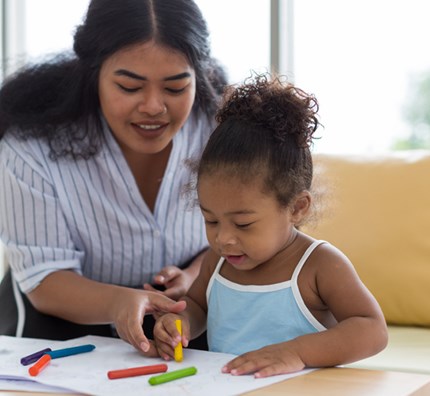Not long after their first birthday, most children will start to make marks with a fat crayon or pencil on paper. This is a child’s first step in learning handwriting, an essential skill that promotes better reading and readiness for school.
A child’s journey into writing tends to follow clear stages, but it’s important to remember: Every child will progress differently in their first five years.
Stage 1: Learning to make my mark.
Between the ages of 15 months and 2-and-a-half years, children experiment with holding a crayon or marker and learn they can create lasting marks.
During this stage, art is the foundation for handwriting. Children mostly draw lines and scribble with large movements, gripping the marker or crayon in the fist. This is a period of creativity, exploration, and joy.
Tip: Letting your child experiment and be creative during this period helps them learn and build confidence.
Stage 2: I’m getting a firmer grip.
From about 2 to 3 years old, children gain more control over hands and fingers. They’re coordinated enough to hold and move objects. They have the basic skill set they need to write.
Now, writing is separated from art and becomes its own way to communicate. Children may scribble with the intention to create words, using wavy lines that go from left to right, to imitate how a sentence looks on a page. Grips change from holding a marker in the fist to holding it between thumb and first finger.
Tip: Reading to your child and showing them words on the pages introduces them to what writing looks like.
Stage 3: These marks mean something.
Overlapping with the second stage, children from about 2-and-a-half to 3-and-a-half years old show a greater understanding of writing. They attempt to write letters, even though their letters may be backwards or lopsided, with rough and bumpy lines.
Even so, parents will recognize their children’s attempts at writing and children begin to understand the idea of symbols and messages. Being able to make these connections, such as taking part in pretend play, helps children learn that letters and words can be combined to communicate meaning.
Tip: Encourage your child to name and draw shapes or play with blocks.
Stage 4: Hey, that’s my name!
From about 4- to 5-years-old, it’s common for children to learn to write their name and understand that the combination of letters is a representation of themselves.
While every child is different, according to the Center for Disease Control (CDC), these are good benchmarks:
- By age 4, children should be able to draw a person with three or more body parts and hold a crayon with their thumb and first finger.
- By age 5, children should be able to name and write some letters.
Tip: Try a handwriting activity with your child. Write out their name and tell them about each letter. Then, get them to write it themselves. Make gentle corrections, and encourage all attempts! Most importantly—have fun.
Supporting your child’s writing journey
Writing is a skill we may take for granted, but it requires children to build muscles, coordination, and the ability to translate ideas in their heads into shapes on a page. It takes time—and help from parents and teachers—for those skills to develop fully.
Some children will learn to write sooner than others, however, developmentally, we should not rush early learners. Honor children’s approximations and do not expect perfection. Formal handwriting and letter formation should occur after children have developed the appropriate fine motor skills, memory, language, visual acuity and concentration. This usually occurs between the ages of 5 and 6.

Once a child starts writing words and sentences, some may show signs they’re having trouble with writing, such as illegible handwriting or difficulty putting ideas into words. If you have concerns, meet with your child’s teacher so they can either assure you your child is on the right track or suggest ways you can help your child succeed.
